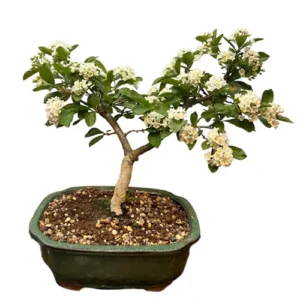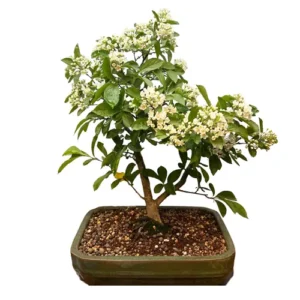Carpinus Betulus
Common Hornbeam Bonsai
Native to Europe, the Ukraine and Turkey. Sparkling yellow and green catkins are displayed in spring from this upright attractive plant. Carpinus betulus have a unique and narrow twig structure for carrying its rich green leaves.
Common Hornbeam Bonsai Care Tips
Placement
Hornbeam appreciates a sunny spot outdoors with considerable aeration. A younger plant will fare better with some shade at the height of summer, older trees can withstand full sun.
Watering
Hornbeam bonsai should be watered as soon as the water is dry. As a rule of thumb once a day during spring and autumn, in the middle of summer, it’s worth watering freely twice a day.
Feeding & Fertilising
Common Hornbeam require feeding once every other month at a regularity of every five to six weeks. A weak solution of general or slow-release fertiliser is advised. Trees in training require a different regimen. After the leaf break in spring, training trees require feeding every week for a month then every other week afterward.
Pruning & Wiring
Pruning your bonsai is important not only to create or maintain an aesthetic style but to also ensure optimal health. Heavy pruning, the removal of large branches is best done in summer for healing properties, but can be done any time of the year. Encourage branching by consistently pruning back shoots in the spring and summer. Pinch out new shoots continuously, as necessary, as soon as two or three leaves have formed.
Common Hornbeam aren’t typically wired but can be when done in spring and summer. We recommend using wires with a thickness that matches the thickness of the branch: if the wire you choose is too thick you will damage the bark. If it is too thin, it won’t be effective.
Repotting
Repotting your tree is an important way to provide a fresh and suitable soil mix and ensure appropriate root health. Repot only when the rootball has become pot-bound. Repot at a regularity of every 3-4 years when so.
Trees that are ready for repotting will require root pruning, a suitable new pot and appropriate soil mix.
When repotting, do not cut back the root mass by a large amount, and choose a well-draining soil mix that has a neutral or slightly higher PH value of 5-6 but not over 7. We tend to use a mixture of different speciality bonsai soils on our trees. Every species is different so please contact us for free soil-mix advice or to take advantage of our repotting service.
Bonsai trees aren’t only magnificent additions to an indoor oasis, they are more than capable of standing out in any garden. Many Bonsai species are incredibly hardy and withstand nature’s colder and damper turns with aplomb making them worthwhile outdoor plants. We have an extensive library of care guides for outdoor bonsai trees. It’s not about selecting the perfect bonsai, it’s about selecting the perfect bonsai for you.
Common Hornbeam Bonsai - Typical Queries
Are Common Hornbeam bonsai prone to pests and diseases?
Common Hornbeam can attract aphids. These can be dealt with by using insecticide. Caterpillars may also intrude but these can be removed by hand. Leaf spot can also befall this species, infected leaves need removing and fungicide should be applied. Avoiding misting in direct sun can mitigate leaf health issues.
How to propagate Common Hornbeam bonsai?
Common Hornbeam can be propagated with seeds, cuttings and through air layering. Cuttings from softwood should be planted in the summer. Seeds should be sown outside in the Autumn.
Can you keep a Common Hornbeam bonsai indoors?
As a hardy deciduous demanding plenty of sun and good air circulation, it’s not advised to keep Common Hornbeam indoors.





















